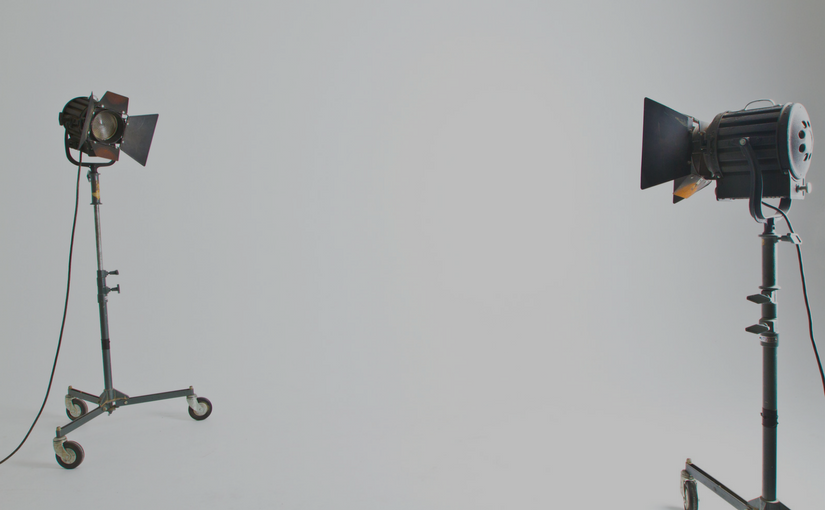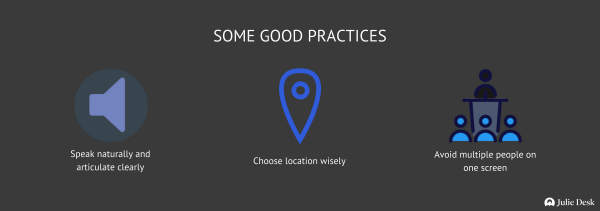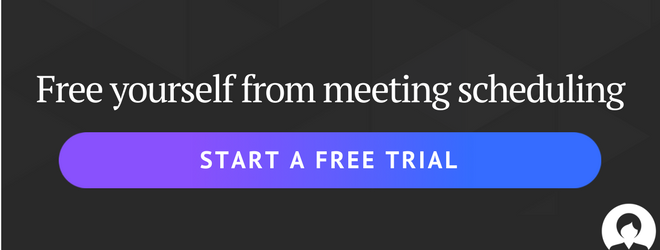Unless you have been living under a rock, you have probably seen the viral video of Professor Robert E. Kelly whose live BBC News interview gets interrupted by his two children – in case this is news to you, we have a copy of the video for you. 🙂
Even though this video ended up being loved by many because of its realness and the adorable kids, there are a number of tricks that could have prevented this.
With all the ongoing technological improvements, video conferencing has slowly inserted itself into our lives and has become a common way to communicate in a professional setting, whether it is for a client meeting, an interview or just to stay in touch with colleagues who are working from home (or vice versa). A video conference call is different from a regular call because it helps you stay meeting focused and organized, brainstorm and find solutions to problems instantly and create a better connection with your interlocutor, but it is just as important. Whether you are a professional or not, chances are that you have already had to take part in a conference call, at least once.
To help you figure out what etiquette to adopt in your visual meetings, and avoid ending up like Professor Robert E. Kelly, here is a little reminder of some of the best practices.
Location
Working remotely has become very common with an increasing number of people choosing to be outside of the work environment. And this raises the question: where do you answer video conference calls when you are working remotely? If you frequently work from home, you probably have a dedicated workspace that you use for focused work. But sometimes, working remotely can also mean having more distractions. At home, remove yourself from every and any type of outside distraction for the duration of your call. If you do have a specific area dedicated, like an office for example, lock the door when you work – like this your children won’t show up ;). If you work in public spaces, like your favorite coffee shop, try to find a very quiet corner or go there at times when you know there aren’t too many people.
Body language and attitude
According to scientists, 93% of our communication is nonverbal and, this makes body language and attitude really important in face-to-face interactions. The way you act and speak during a video conference are probably the most important parts of the call. Just like in a physical meeting, there are good practices to take seriously.
- First and foremost, be punctual. Being late is no way to start a productive meeting.
- Don’t be fidgety. This means sitting straight, remaining calm and staying focused. Try to avoid yawning or playing with your hands. The video above is a perfect example of being calm and collected in the midst of the most distraction that is difficult to handle in a professional setting.
- Raise camera to eye-level so that you are not looking up at your interlocutor. And remember, your camera is not there for you to look at your reflection, therefore keep your eyes on the person you are speaking to and not on yourself. There is always a mirror for that. 😉
- Speak slowly, and articulate your words clearly. Before your conference call, do an audio check, not only to check that your equipment is working but also to identify your best speaking volume so that you don’t speak too loud on video. If you do, your interlocutors will tend to turn down the volume and this could cause them to miss out on some key things you might say.
- If you are in a conference call with several people, let people speak in turn and don’t interrupt. If you speak over one another, nobody will be able to hear anything.
- Avoid having side conversations with other people. However, it can happen that, during a video, you need to ask a colleague for a precision on a specific matter, in that case, remember to put your mic on mute so that your interlocutor understands that you are not speaking to them.
- Jokes can be used to lighten the mood and add some personality to the call. But don’t over do it.
Tools and Equipment
To avoid having to get up mid-conference to look for an item you forgot, you need to know the tools required for a successful conference call.
- An effective online video conferencing service: Obviously, most computers have built-in webcams and therefore allow you to have a successful video call. But, other than that, you can also use online services for an effective call. While one of the most effective tools for one-on-one calls is Skype (desktop and mobile), Google Hangouts and Join.me have been proved to be support group calls successfully. GoToMeeting is also one of the best services for your virtual meetings.
- A controlled headset – In cases of remote work, and even sometimes in an open space office, you will require a headset or fully functioning earphones. Headsets are usually a better choice because they offer you some of the best options, especially the noise canceling option, which helps you avoid getting distracted by the noise that surrounds you.
- A notepad and 2 pens – As a general rule, taking notes can come very handy when you need to remember important information or remember names when it’s a call with la large number of participants. But, you might be wondering why you need to take handwritten notes when you are sitting in front of a screen with a multitude of note-taking tools available at your fingertips. Well, during a video call, taking notes electronically can easily become noisy for your interlocutor who can hear all the typing on your computer keypad. So, if you know that you write down a lot of things, it might be better and wiser to make use of a notepad and a pen and transcribe on your computer once the call is done. Everyone at Julie Desk is always ready with a pen and a notepad to take notes during our numerous conference calls with clients.
- A really good internet connection: This goes without saying. If your connection is not up to par, then your video will be less than perfect. In the case of a webinar or a call, having a good internet connection can also allow you to record the call so that you can review it at a later time or use it to draw some additional information from it.
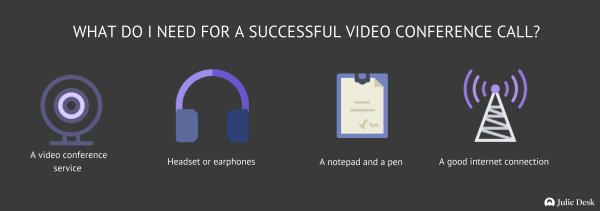
Clothing
Beyond the technical difficulties that may occur during a video call, your choice of clothing can also affect the success of your video conference. It is important to make an informed decision when you are choosing what to wear, especially when working remotely. The two most important tips in this regard are to never wear anything that could give the illusion that you are not wearing anything and never wear pajamas, no matter how suitable they might be for work. This piece of advice may seem obvious but if you work from home often, you are probably in the habit of wearing comfortable clothes. There is nothing wrong with that, but what happens when your boss asks for an impromptu video call and you are still in your pajamas? To avoid having to suddenly run around looking for ‘decent’ pieces of clothing to talk to your boss, maybe just dress well, even at home. In addition, doing this can actually make you more productive.
The texture or type of some pieces of clothing can also cause a negative visual effect on your interlocutor’s camera. For example, wearing striped shirts may create a strobing effect for the people on the other side of the camera. In the same way, wearing intricate patterns can also distracting. It’s best to stick to solid and neutral colors.
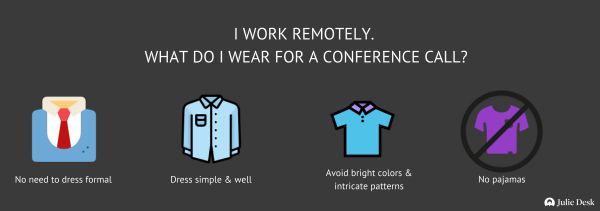
Want to set up your next conference call? Remember, Julie can always schedule it for you! 😉 When scheduling a meeting with more than 2 participants, Julie automatically sets the meeting to a conference call and she provides details – conference call, skype, video conference, hangouts or other details available in her employer’s preference settings – to all meeting participants.
Any comments? Feel free to share with us your best practices for conference calls.
